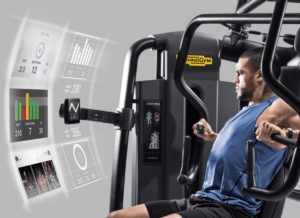Technogym: helping you to get in shape for the summer

The world has changed since Arnold Schwarzenegger began weight training at the age of 15. Gym equipment companies, such as Technogym, are embracing digitalization to adapt new technologies into their machines, improve exercise performance and provide a cutting-edge experience to fitness practicioners.
Time for a six-pack abs
I know, winter has barely started and we are already thinking in the summer. Actually, most of us are already dreaming with our end of the year break at Rio de Janeiro’s famous Ipanema beach. Hence, now is the perfect time to get in shape, right?
Getting in shape – be for esthetic or healthy purposes – is now a hot topic. Baby boomers want to look younger, millennials want to stay younger. Gyms are our second home and boy, we are spending a lot of money and time to optimize our exercises.
Companies such as Nike and Apple are already shifting their focus to fitness digitalization. Be investing in fitness trackers, be investing in “smart clothes” and mobile applications that are built to leverage your train, the fitness market is expanding at a fast pace. Even traditional companies such as Polar and Suunto are now facing higher competition from newborns such as Jawbone and Fitbit.
Believe it or not, the major shift is actually taking place in the gyms. One of the most traditional gym equipment companies is heavily investing in digitalization to make your exercises not only more pleasurable but also more efficient. Technogym, a company founded in 1983 in Cesena, Italy, is one of the world’s biggest manufacturer of fitness equipment [1] who is taking the lead on digital transformation. What was once a simple treadmill or a chest press bench, are becoming fancy machines that help you to get in shape and better understand your body and daily exercises.
Push for digitalization
Technogym embraced digitalization as a driver for future growth as recreational sports enthusiast grow their interest in using data to track their progress. The company is not alone: in its 2015 annual report, Adidas referred digitalization as one of the main trends affecting the sector [2]. The increase in competitiveness also pushed the company to offer more reliable and smart products targeting not only professionals but in especial, amateurs practicians. Despite being a $21.8 billion (revenue) industry [3], US health clubs are struggling to justify pricey memberships: having a cutting-edge gym equipment became a useful marketing tool that ultimately benefits its members.
Initially, Technogym invested in design as an outcome of new technologies that enable a better understanding of the human body muscle mechanics. The company employed new technologies creating gym equipment that isolates muscle members and concentrate efforts in specific geometry movements. It also incorporated different materials in its machines to improve its durability, resistance, and design. R&D is, indeed, a core division within the company: it first fitness software was launched in 1996 integrating TV to treadmills. Later on, in 2003, Technogym enabled web connectivity and launched several online/offline applications to enhance fitness training.
But it went far beyond: from a mobile application that allows users to connect its gym machines to their smartphones [4], to a stand-alone touch-screen kiosk that allows trainers and practitioners to manage training sessions and workout routines [5], and a machine attached LCD screens with sensors that track the exercise movement’s quality and speed, providing real-time guidance to improve users’ training performance (see photo below)[6].

Challenges just a few reps away
Technogym is facing a new challenge as smartphones ownership increase and fitness mobile applications are becoming very popular. As a consequence, gym-goers are increasingly changing their in-door exercise habits [7] to more social outdoor fitness training activities at little to no costs such as group cycling, group running, open-air yoga, etc. [8]. Simple digitalization of gym machines and mobile integration delivered short-term gains for the Technogym, however the company needs to adapt.
Technogym has been aware of such shift in trend and is increasingly investing in R&D to develop equipment that combines technology and open air activities. Taking digitalization outdoor is the nowadays main challenge at the company. The shift: instead of focusing on gyms as final consumers (B2B), the company is pushing for a higher focus on the final users (B2C), leveraging its brand recognition and quality association. Is this enough? So far, few new disruptive products have been taken to the market and the company still has to prove itself as a fast responder to the needs of modern fitness adopters.
(704 words)
References:
[1] “Who we are” – Technogym website, accessed in Nov/2016. http://www.technogym.com/us/who-we-are/nerio-alessandri-technogym-founder-and-president
[2] Adidas 2015 Annual Report. http://www.adidas-group.com/media/filer_public/e9/73/e973acf3-f889-43e5-b3c0-bc870d53b964/2015_gb_en.pdf
[3] Sawers, P. “The future of gyms”, http://thenextweb.com/insider/2013/10/19/the-future-of-gyms/
[4] Technogym App – company website, accessed in Nov/2016. http://www.technogym.com/us//wellness/technogym-app
[5] Technogym Unity Self Skillmill App – company website, accessed in Nov/2016. http://www.technogym.com/us/unity-self-skillmill.html
[6] Technogym Selection Pro – company website, accessed in Nov/2016. http://www.technogym.com/us/line/selection-pro/
[7] Gym vs Outdoor Fitness Training: The Pros and Cons. Accessed in Nov/16. http://www.fitday.com/fitness-articles/fitness/cardio/gym-vs-outdoor-fitness-training-the-pros-and-cons.html
[8] Reynolds, G. “The Benefits of Exercising Outdoors”. http://well.blogs.nytimes.com/2013/02/21/the-benefits-of-exercising-outdoors/



This article really calls into question the value proposition of gyms these days. As more people are better able to track their fitness using technology (fitbits, Apple Watch, etc.), do we still need personally trainers? And as more people take advantage of communal, social exercise, do we still need the community of the gym to incentivize exercise? I wonder if the digitization of gym facilities will be enough to justify the high prices these facilities are currently demanding. Personally, I hope that as consumers are given more options for informed physical fitness, demand for gyms will decrease and prices for gym memberships will decrease as well.
Thanks for the post! I doubt if the emergence of fitness mobile apps have really switched gym-goers to outdoor fitness trainers, given that gym provides full set of equipment for both cardio and weight training, whereas for outdoors its mostly cardio. Also gyms have trainers who are important value creator for those who are serious about workout. Additionally, in large cities where people work out close to their workplace, amenities such as shower and lockers are also important for gym-goers. While I do see apps such as “”Runkeeper” or “PokemonGo” attracting people to exercise outdoors, I don’t think it would fundamentally drive people out of the gyms.